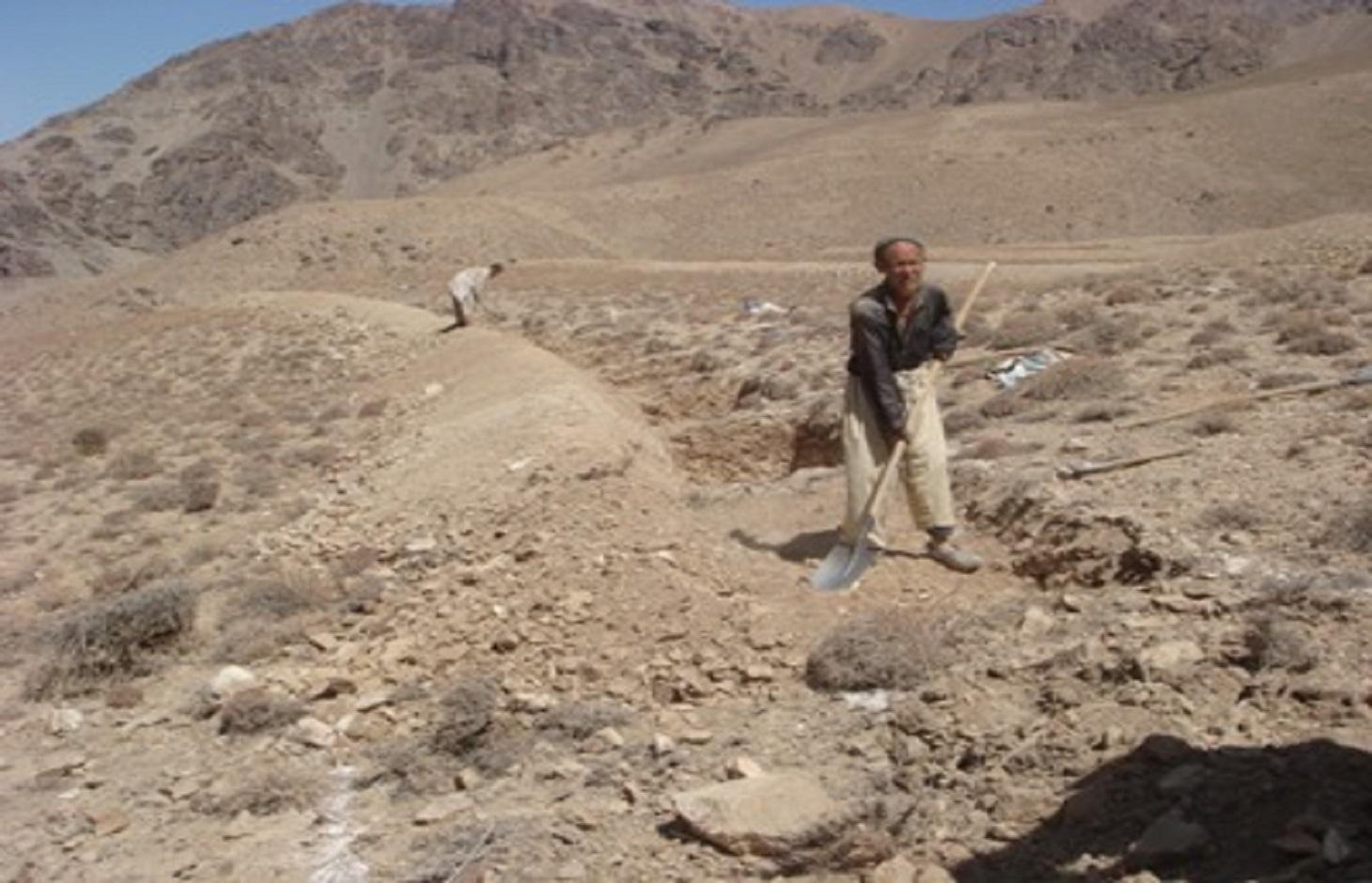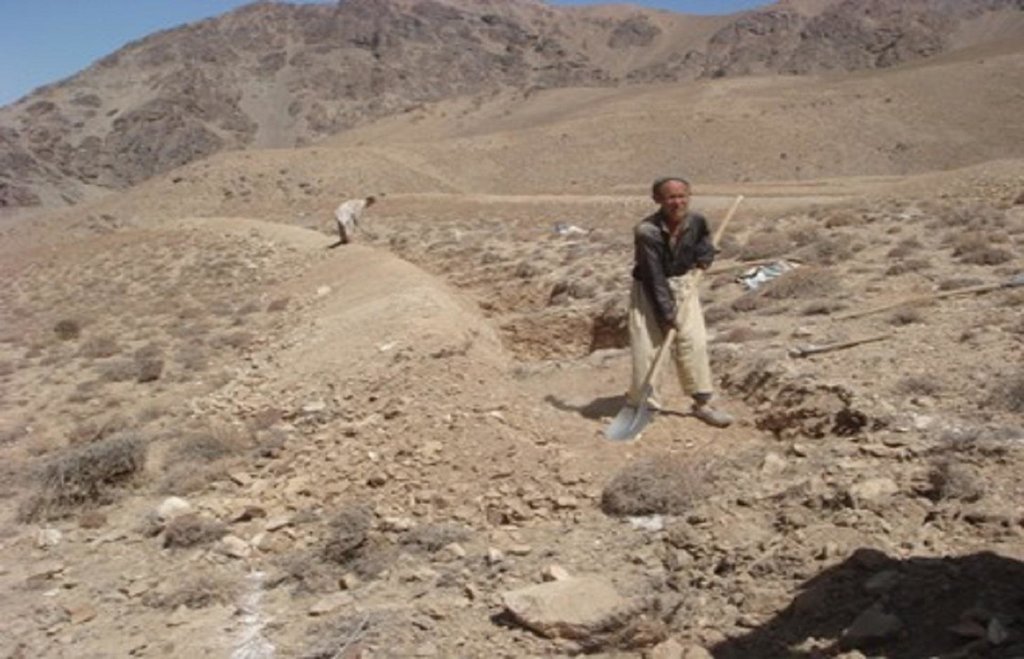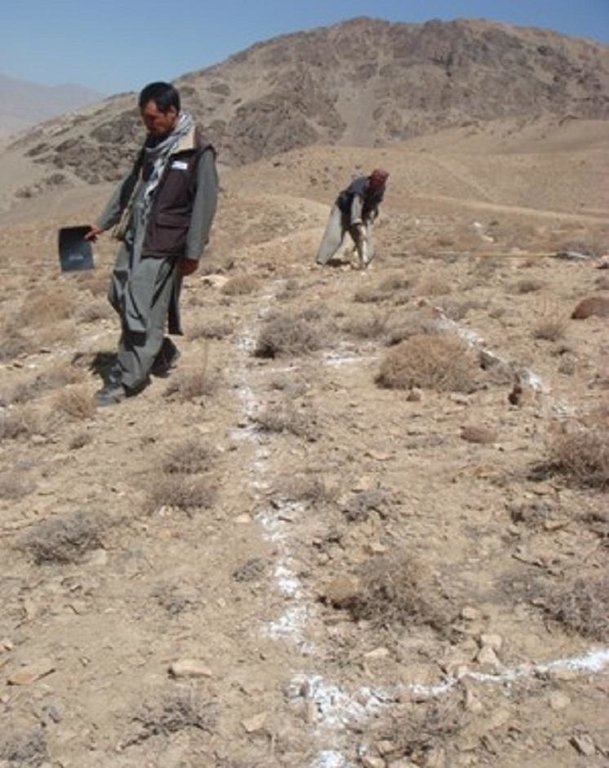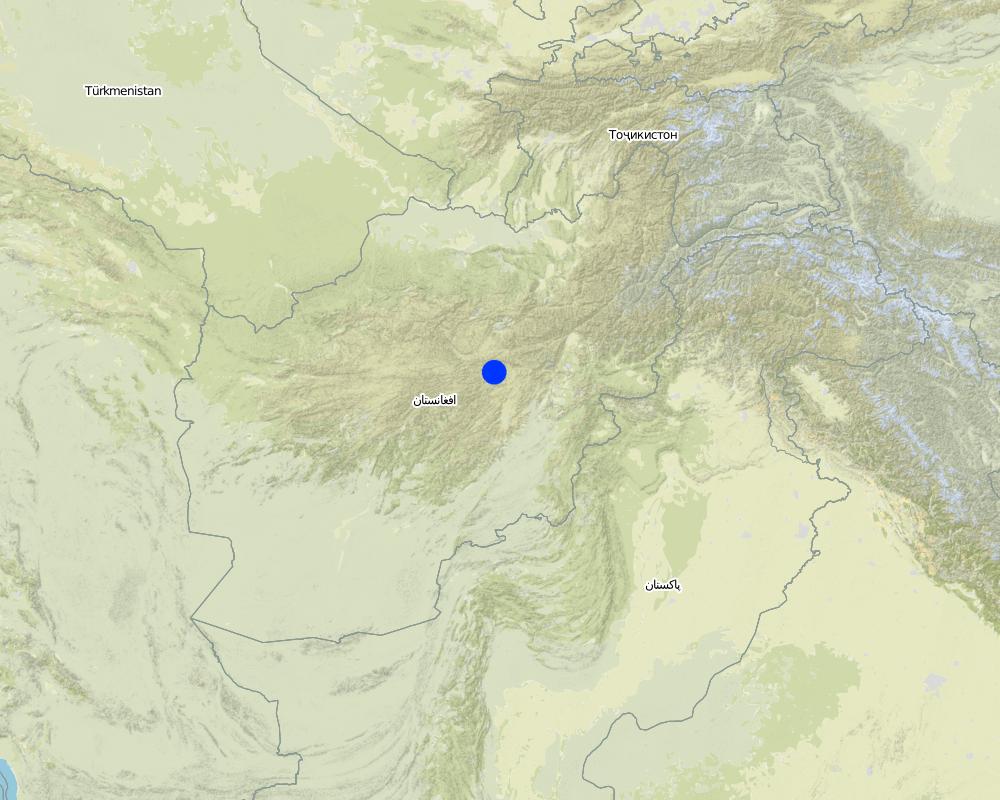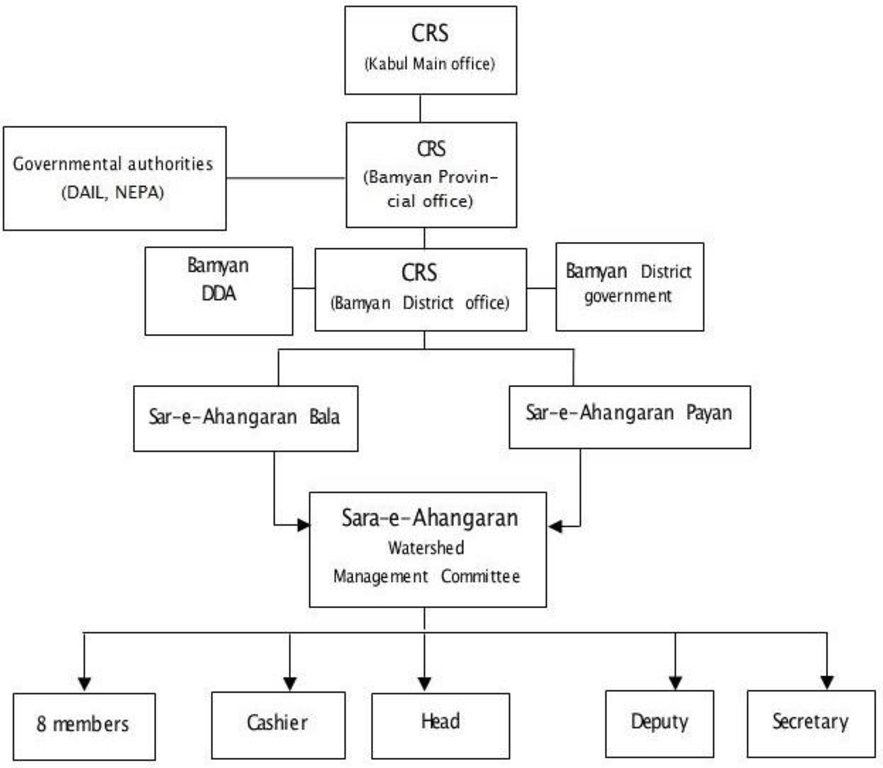Community-Based Watershed Management [อัฟกานิสถาน]
- ผู้สร้างสรรค์:
- การอัพเดท:
- ผู้รวบรวม: Aqila Haidery
- ผู้เรียบเรียง: –
- ผู้ตรวจสอบ: Deborah Niggli
Mudiriat Aabreza Tawasut Mardum (Dari)
approaches_2612 - อัฟกานิสถาน
ดูส่วนย่อย
ขยายทั้งหมด ย่อทั้งหมด1. ข้อมูลทั่วไป
1.2 รายละเอียดที่ติดต่อได้ของผู้รวบรวมและองค์กรที่เกี่ยวข้องในการประเมินและการจัดเตรียมทำเอกสารของแนวทาง
ผู้เชี่ยวชาญ SLM:
ผู้เชี่ยวชาญ SLM:
ผู้เชี่ยวชาญ SLM:
Montzieux Mathilde
อัฟกานิสถาน
ผู้เชี่ยวชาญ SLM:
Hazem Zainullah
อัฟกานิสถาน
ผู้เชี่ยวชาญ SLM:
Alemi Saadat
อัฟกานิสถาน
ผู้เชี่ยวชาญ SLM:
Ershad Mustafa
อัฟกานิสถาน
ผู้เชี่ยวชาญ SLM:
Ahmadi Reza
อัฟกานิสถาน
ชื่อของโครงการซึ่งอำนวยความสะดวกในการทำเอกสารหรือการประเมินแนวทาง (ถ้าเกี่ยวข้อง)
HELVETAS (Swiss Intercooperation)1.3 เงื่อนไขที่เกี่ยวข้องกับการใช้ข้อมูลที่ได้บันทึกไว้ผ่านทาง WOCAT
วันที่เก็บรวบรวมข้อมูล (ภาคสนาม):
10/11/2011
ผู้รวบรวมและวิทยากรหลักยอมรับเงื่อนไขเกี่ยวกับการใช้ข้อมูลที่ถูกบันทึกผ่านทาง WOCAT:
ใช่
1.4 การอ้างอิงถึงแบบสอบถามเรื่องเทคโนโลยี SLM
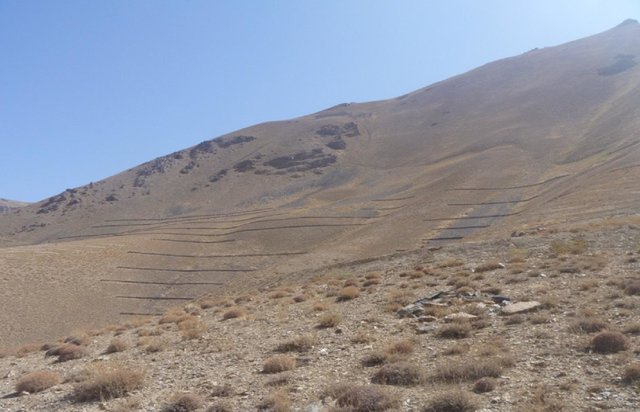
Stone wall [อัฟกานิสถาน]
Contour stone walls constructed on moderate to steep slopes to retain water and sediments and trap snow.
- ผู้รวบรวม: Aqila Haidery
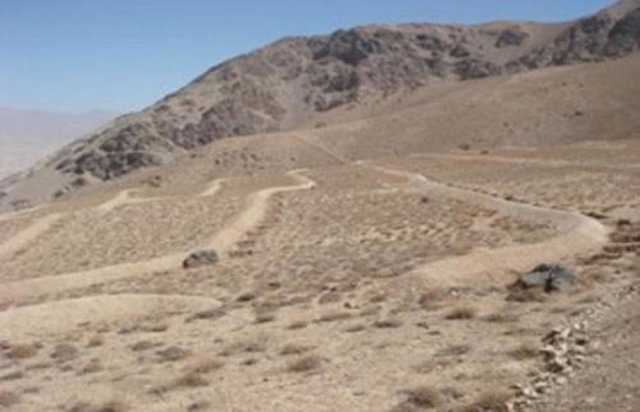
Contour Trench Bund [อัฟกานิสถาน]
Contour trench bund applied on contour lines of moderate slope to trap run-off to improve infiltration and reduce flash floods.
- ผู้รวบรวม: Aqila Haidery
2. คำอธิบายของแนวทาง SLM
2.1 การอธิบายแบบสั้น ๆ ของแนวทาง
Sustainable implementation of watershed management through appropriate SLM technologies, formation of organizational structures and capacity building of stakeholders
2.2 การอธิบายอย่างละเอียดของแนวทาง
การอธิบายอย่างละเอียดของแนวทาง:
The overall objective of the community-based watershed management project implemented at Sar-e-Ahangaran was to reduce water induced disaster risks and improve people’s livelihoods. The project was implemented by Catholic Relief Services (CRS) with people’s support and funding assistance from USAID.
About 67 hectares of degraded land has been rehabilitated since 2009 through various soil and water conservation measures like stone walls, contour trenches and plantation of fodder species such as alfalfa. The local communities are also protecting the treated areas from grazing and shrub cutting.
With facilitation from CRS, a 15-member watershed management committee was appointed by the participating families. This was important for organizing watershed related works and for the sustainability of project interventions. Some rules for managing the selected watershed were also formulated in a participatory way. For instance, if anyone is found grazing animals at the site, he has to give one sheep to the watershed committee as a fine.
CRS has provided training and technical support to the watershed committee members and workers for project implementation and monitoring. The daily workers were selected from the local communities by the watershed committee and paid in cash as per national norms for their labor. CRS also organized awareness raising workshops regarding environmental conservation and water-shed management and the entire community including teachers and students participated in these village events.
As a result of Sar-e-Ahangaran watershed management project, the people have a more positive attitude towards natural resource management. The formation and capacity building of the watershed management committee is a step towards ensuring long-term sustainability of the project outputs and community owner-ship. The watershed committee is not yet registered with the government but for future sustainability, this will be an important activity. The Islamic Republic of Afghanistan is in the process of formulating a comprehensive community-based natural resource management strategy. Once in place, the Sar-e-Ahangaran community can take advantage of that strategy if the watershed committee is formally registered with the Ministry of Agriculture, Irrigation and Livestock (Bamyan).
The Community-Based Watershed Management approach is documented by Sustainable Land Management Project /HELVETAS Swiss Intercooperation which is funded by Swiss Agency for Development and Cooperation with close support and cooperation of the Catholic Relief Service (CRS).
2.3 รูปภาพของแนวทาง
2.5 ประเทศ ภูมิภาค หรือสถานที่ตั้งที่ได้นำแนวทางไปใช้
ประเทศ:
อัฟกานิสถาน
ภูมิภาค/รัฐ/จังหวัด: :
Bamyan
ข้อมูลเฉพาะเพิ่มเติมของสถานที่ตั้ง:
Sar-e-Ahangaran, Bamyan center
Map
×2.6 วันที่เริ่มต้นและสิ้นสุดของแนวทาง
ระบุปีที่เริ่ม:
2009
2.7 ประเภทของแนวทาง
- ใช้โครงงานหรือแผนงานเป็นฐาน
2.8 เป้าหมายหรือวัตถุประสงค์หลักของแนวทาง
The Approach focused mainly on SLM with other activities (Disaster Risk Reduction, Rural Livelihoods Improvement)
The overall objective of the project was to reduce watershed induced disaster risks and improve rural livelihoods through SLM technologies and community based sustainable approaches
The SLM Approach addressed the following problems: Lack of people’s knowledge regarding sustainable management of natural resources and disaster risk reduction, lack of knowledge, technical and organisational capacities on sustainable land management technologies for degraded lands
2.9 เงื่อนไขที่เอื้ออำนวยหรือเป็นอุปสรรคต่อการนำเทคโนโลยีภายใต้แนวทางนี้ไปปฏิบัติใช้
บรรทัดฐานและค่านิยมทางสังคม วัฒนธรรม ศาสนา
- เป็นอุปสรรค
People did not have a good idea about how to conserve the environment and at the same time reduce disaster risks and improve their livelihoods
Treatment through the SLM Approach: Training and education via sharing knowledge with watershed committees in Waras forming maintenance committees who should look after restrictions about grazing. Practical demonstration of potential SLM technologies
การมีไว้ให้หรือการเข้าถึงแหล่งการเงินและบริการ
- เป็นอุปสรรค
People do not have financial capacities
Treatment through the SLM Approach: Project had a Cash for Work but learning approach
กรอบแนวทางในการดำเนินการด้านกฎหมาย (การถือครองที่ดิน สิทธิในการใช้ที่ดินและน้ำ)
- เป็นอุปสรรค
As the land is formally owned by the government, people did not invest much in sustainable practices. During project initiation, people were also sceptical and rejected the project idea as they thought that by digging trenches, the project was trying to search for gold
Treatment through the SLM Approach: Through several discussions and clarifications and by assurances from the government, people were convinced that the project had no hidden motives and gradually their trust in CRS increased
ความรู้เกี่ยวกับ SLM การเข้าถึงการสนับสนุนด้านเทคนิค
- เป็นอุปสรรค
Lack of knowledge about SLM measures
Treatment through the SLM Approach: Training and technical support from CRS
3. การมีส่วนร่วมและบทบาทของผู้มีส่วนได้ส่วนเสียที่เกี่ยวข้อง
3.1 ผู้มีส่วนได้ส่วนเสียที่เกี่ยวข้องในแนวทางนี้และบทบาท
- ผู้ใช้ที่ดินระดับท้องถิ่นหรือชุมชนระดับท้องถิ่น
- องค์กรที่ขึ้นอยู่กับชุมชน
3.2 การเกี่ยวข้องของผู้ใช้ที่ดินระดับท้องถิ่นหรือชุมชนระดับท้องถิ่นในช่วงต่างๆของแนวทาง
| ความเกี่ยวข้องของผู้ใช้ที่ดินระดับท้องถิ่นหรือชุมชนระดับท้องถิ่น | ระบุผู้ที่มีส่วนเกี่ยวข้องและอธิบายกิจกรรม | |
|---|---|---|
| การริเริ่มหรือการจูงใจ | ปฏิสัมพันธ์ | CRS discussed land use problems and formulated the project. Project site was selected by the participating families and respective CDCs |
| การวางแผน | ปฏิสัมพันธ์ | CDC and watershed members were involved in the planning but not the whole community |
| การดำเนินการ | จ่ายเงินหรือสนับสนุนจากภายนอก | Implementation was by the local communities with cash for work approach |
| การติดตามตรวจสอบหรือการประเมินผล | ระดมกำลังด้วยตนเอง | Voluntary monitoring group to look after the environment. Also joint monitoring by project stakeholders |
| Research | ไม่ลงมือ |
3.3 แผนผังแสดงขั้นตอนการทำงาน (ถ้ามี)
คำอธิบาย:
The organizational Chart of Sar-e_Ahangaran Watershed Management Committee
ผู้เขียน:
Catholic Relief Service (CRS)
3.4 การตัดสินใจเลือกใช้เทคโนโลยี SLM
ระบุผู้ที่ทำการตัดสินใจเลือกเทคโนโลยีมากกว่าหนึ่งวิธีไปปฏิบัติใช้:
- ผู้เชี่ยวชาญ SLM เป็นผู้ตัดสินใจหลัก ที่ติดตามให้คำปรึกษากับผู้ใช้ที่ดิน
การอธิบาย:
The area was selected by the community
Decisions on the method of implementing the SLM Technology were made by mainly by SLM specialists with consultation of land users. However, workers were selected by the watershed committee members in consultation with their community development councils (CDCs).
4. การสนับสนุนด้านเทคนิค การสร้างขีดความสามารถ และการจัดการด้านความรู้
4.1 การสร้างขีดความสามารถ / การอบรม
ได้มีการจัดอบรมให้แก่ผู้ใช้ที่ดินหรือผู้มีส่วนได้ส่วนเสียคนอื่น ๆ หรือไม่:
ใช่
ให้ระบุว่าใครเป็นผู้ได้รับการอบรม:
- ผู้ใช้ที่ดิน
- Project field officers, Land users, CDC and Watershed Management Committee members, teacher and students, both women and men
รูปแบบการอบรม:
- กำลังดำเนินการ
- เกษตรกรกับเกษตรกร
รูปแบบการอบรม:
- organizing courses
หัวข้อที่พูด:
contour trench and stone wall technologies, tree planting, importance of pasture management and watershed management
4.2 การบริการให้คำแนะนำ
ผู้ใช้ที่ดินมีการเข้าถึงการรับบริการให้คำปรึกษาหรือไม่:
ใช่
การอธิบาย/แสดงความคิดเห็น:
CRS provided continuous advice; Key elements: increase awareness by forming a watershed committee, technical support of the committee
Advisory service is inadequate to ensure the continuation of land conservation activities; The government or other advisory service is still inadequate to ensure the continuation of land conservation activities. The government authorities visited the project only once, at the end of the project. They did not provide much support; however, as the land belongs formally to the state, they did not have any objections for applying watershed management measures.
4.3 การเสริมความแข็งแกร่งให้กับสถาบัน (การพัฒนาองค์กร)
สถาบันได้รับการจัดตั้งขึ้นมาหรือเสริมความแข็งแกร่งโดยแนวทางนี้หรือไม่:
- ใช่ ปานกลาง
ระบุระดับของสถาบันที่ได้รับการเสริมความแข็งแกร่งหรือจัดตั้งขึ้นมา:
- ท้องถิ่น
ให้รายละเอียดเพิ่มเติม :
CDCs and watershed management committees. Schools teachers and students also received training
4.4 การติดตามตรวจสอบและประเมินผล
การติดตามตรวจสอบและประเมินผลเป็นส่วนหนึ่งของแนวทางหรือไม่:
ใช่
ความคิดเห็น:
bio-physical aspects were regular monitored by project staff through measurements; indicators: Water quality and quantitative measurements
technical aspects were ad hoc monitored by project staff, land users, other through observations; indicators: ad hoc field visits and monitoring of structural quality
socio-cultural aspects were ad hoc monitored by project staff through measurements; indicators: Hosuehold survey
economic / production aspects were ad hoc monitored by project staff through measurements; indicators: Household survey
area treated aspects were ad hoc monitored by project staff through observations; indicators: Other areas where technology has been applied
no. of land users involved aspects were regular monitored by land users through measurements; indicators: Selecting the beneficiaries
management of Approach aspects were None monitored by land users through observations; indicators: Monitoring the community which looks after the pasture management
There were few changes in the Approach as a result of monitoring and evaluation: especially with regard to organisational structure for monitoring works
4.5 การวิจัย
การวิจัยเป็นส่วนหนึ่งของแนวทางหรือไม่:
ใช่
- Farm research
ให้ข้อมูลเพิ่มเติมและให้ระบุผู้ทำการวิจัย:
Topics included technology functions, vegetation status before and after project, monitoring of spring (located below) water quality and quantity.
5. การสนับสนุนด้านการเงินและวัสดุอุปกรณ์
5.1 ระบุงบประมาณประจำปีสำหรับแนวทาง SLM นี้
ถ้าหากว่างบประมาณประจำปีไม่เป็นที่ทราบแน่นอน ให้ระบุช่วงลงไป:
- 10,000-100,000
แสดงความคิดเห็น (แหล่งของการระดมทุน ผู้บริจาคคนสำคัญ):
Approach costs were met by the following donors: international non-government: 99.0%; local community / land user(s): 1.0%
5.2 การสนับสนุนด้านการเงิน / วัสดุอุปกรณ์ให้แก่ผู้ใช้ที่ดิน
ผู้ใช้ที่ดินได้รับการสนับสนุนด้านการเงิน / วัสดุอุปกรณ์ไปปฏิบัติใช้เทคโนโลยีหรือไม่:
ไม่ใช่
5.4 เครดิต
มีการจัดหาเครดิตมาให้ภายใต้แนวทาง SLM หรือไม่:
ไม่ใช่
5.5 แรงจูงใจหรือเครื่องมืออื่น ๆ
แรงจูงใจหรือเครื่องมืออื่น ๆ ได้ถูกนำไปใช้ส่งเสริมการใช้เทคโนโลยี SLM หรือไม่:
ไม่ใช่
6. การวิเคราะห์ผลกระทบและการสรุป
6.1 ผลกระทบของแนวทาง
ช่วยให้ผู้ใช้ที่ดินนำเอาเทคโนโลยี SLMไปใช้และบำรุงรักษาสภาพไว้ได้หรือไม่:
- ไม่ใช่
- ใช่ เล็กน้อย
- ใช่ ปานกลาง
- ใช่ อย่างมาก
Land cover by vegetation improved significantly. Flash floods and snow avalanche problems were reduced, and the community members were more aware about the technologies and approaches for sustainable land management.
ทำให้กลุ่มด้อยโอกาสมีอำนาจทางสังคมและเศรษฐกิจหรือไม่:
- ไม่ใช่
- ใช่ เล็กน้อย
- ใช่ ปานกลาง
- ใช่ อย่างมาก
People got cash for work and some of the families could pay back their loans through this income.
The land belongs to the state and the water use right is as well open access and and organized manner. In this particular land land use problem or water use problems have not been seen.
Did other land users / projects adopt the Approach?
- ไม่ใช่
- ใช่ เล็กน้อย
- ใช่ ปานกลาง
- ใช่ อย่างมาก
There were constraints from the people in the beginning. Now a similar approach with some modifications is being implemented in other watersheds as well as a result of this project.
Did the Approach lead to improved livelihoods / human well-being?
- ไม่ใช่
- ใช่ เล็กน้อย
- ใช่ ปานกลาง
- ใช่ อย่างมาก
They got more money via the cash for work; however, there is no impact for the livestock because the pasture area is big enough.
Did the Approach help to alleviate poverty?
- ไม่ใช่
- ใช่ เล็กน้อย
- ใช่ ปานกลาง
- ใช่ อย่างมาก
due to cash for work approach and increased production of wheat, potato and other agricultural products as a result of reduced flood risks
6.2 แรงจูงใจหลักของผู้ใช้ที่ดินเพื่อที่จะนำ SLM ไปปฏิบัติใช้
- กำไร (ความสามารถ) อัตราส่วนค่าใช้จ่ายต่อผลประโยชน์ที่เพิ่มขึ้น
- กฎและระเบียบ (ค่าปรับ) หรือการบังคับใช้
- to get employed through cash for work
- reduce flood risks
- Understand the importance of watershed
- Understand the importance of NRM
- Ownership of the project activities
6.3 ความยั่งยืนของกิจกรรมของแนวทาง
ผู้ใช้ที่ดินสามารถทำให้สิ่งต่างๆ ที่ได้ปฏิบัติใช้โดยแนวทางนี้ยั่งยืนได้หรือไม่ (โดยไม่มีการสนับสนุนจากภายนอก):
- ไม่แน่ใจ
ถ้าตอบว่าไม่หรือไม่แน่ใจ ให้ระบุและแสดงความคิดเห็น :
but CRS continues to build capacities of watershed committees and support plantation of fodder species so that people get direct benefits and the project is sustained.
6.4 จุดแข็งและข้อได้เปรียบของแนวทาง
| จุดแข็ง / ข้อได้เปรียบของแนวทางในทัศนคติของผู้รวบรวมหรือวิทยากรหลัก |
|---|
| Less damage to some agricultural land located below the watershed sites due to flash floods |
| Prevention of snow slide |
| Increased water in the spring |
| Plant coverage of the area increased |
| Prevention from soil erosion |
6.5 จุดอ่อน / ข้อเสียเปรียบของแนวทางและวิธีในการแก้ไข
| จุดอ่อน / ข้อเสียเปรียบในทัศนคติของผู้รวบรวมหรือวิทยากรหลัก | สามารถแก้ไขปัญหาได้อย่างไร |
|---|---|
| Watershed management committee is not registered | CRS should facilitate registration of the committee with the Department of Agriculture, Irrigation and Livestock in Bamyan |
| People are not taking care of the plantations | People must understand the importance of plantations. The project should figure out the reasons why people are not interested in plantation activities and adjust approaches accordingly |
7. การอ้างอิงและการเชื่อมต่อ
7.1 วิธีการหรือแหล่งข้อมูล
- ไปเยี่ยมชมภาคสนาม การสำรวจพื้นที่ภาคสนาม
- การสัมภาษณ์กับผู้ใช้ที่ดิน
ลิงก์และโมดูล
ขยายทั้งหมด ย่อทั้งหมดลิงก์

Stone wall [อัฟกานิสถาน]
Contour stone walls constructed on moderate to steep slopes to retain water and sediments and trap snow.
- ผู้รวบรวม: Aqila Haidery

Contour Trench Bund [อัฟกานิสถาน]
Contour trench bund applied on contour lines of moderate slope to trap run-off to improve infiltration and reduce flash floods.
- ผู้รวบรวม: Aqila Haidery
โมดูล
ไม่มีโมดูล


